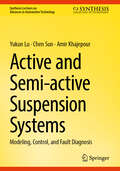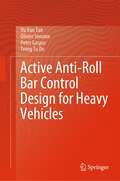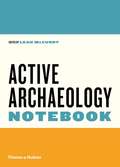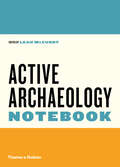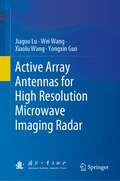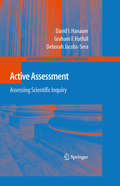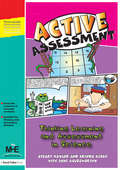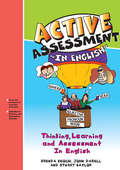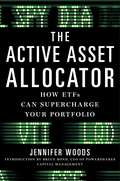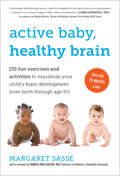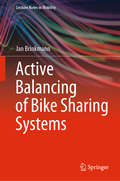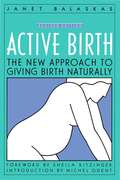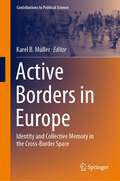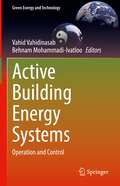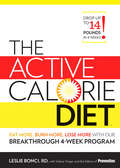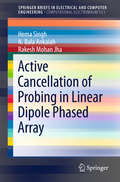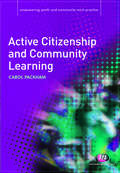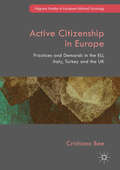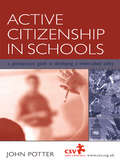- Table View
- List View
Active and Programmable Networks for Adaptive Architectures and Services
by Syed Asad HussainMost conventional networks are passive, with only basic traffic monitoring, management, routing, and congestion control. At best, they can be called reactive. Deploying new functions and integrating new standards into these architectures is difficult due to the rigid embedding of software and hardware into the network components. Active and Program
Active and Semi-active Suspension Systems: Modeling, Control, and Fault Diagnosis (Synthesis Lectures on Advances in Automotive Technology)
by Yukun Lu Chen Sun Amir KhajepourThis book comprehensively explores fundamental aspects of adaptive vehicle suspension systems, offering numerous examples for suspension modeling, control, estimation, and fault diagnosis and prognosis methodologies. It is intended for senior undergraduate and graduate students, vehicle R&D departments, and anyone with an interest in the design and control of adaptive or active suspension systems. In order to simplify the understanding of more difficult concepts, the book uses a step-by-step approach along with pictures, graphs, and practical examples. The book begins with an introduction of vehicle adaptive suspensions, highlighting some common mass-produced products in recent decades. Furthermore, three widely-used mathematical models of adaptive suspension systems are derived. Subsequently, four suspension control algorithms and gain-adaptive approaches are introduced, accompanied by MATLAB/Simulink programming examples for enhanced understanding and practical implementation. Lastly, the fault diagnosis and prognosis of adaptive suspension systems are introduced.
Active Anti-Roll Bar Control Design for Heavy Vehicles
by Vu Van Tan Olivier Sename Peter Gaspar Trong Tu DoThis book provides a comprehensive overview of active anti-roll bar systems on heavy vehicles as one of the most effective solutions for improving the roll stability of these vehicles. Due to the characteristics of these vehicles with heavy loads and high center of gravity, the possibility of roll instability occurs frequently and causes serious consequences for human life, vehicles, and traffic infrastructure. The book gives readers an in-depth survey of the roll instability characteristics of heavy vehicles such as single-unit trucks with rigid and flexible frames, and tractor semi-trailers. It then introduces an active anti-roll bar system, the electro-hydraulic actuators which use control methods such as LQR optimal and H∞ robust controller design. This work introduces a new control method, which is a combination of robust control with the linear parameter varying system (H∞/LPV). The validation of the new hybrid method is carried out using the nonlinear truck model from the TruckSim® software to assess the roll stability of heavy vehicles in order to limit the rollover accident. A number of examples are provided to illustrate the research results, which helps the readers have a practical and easy approach that can be applied to other active anti-roll bar systems for most forms of transport vehicles in general. This book caters to academics and practitioners who are interested in active anti-roll bar systems for the typical heavy vehicle available worldwide.
Active Archaeology Notebook
by Leah McCurdyThe Active Archaeology Notebook offers effective and fun activities for the archaeology classroom. Conceived by a team of instructors from the SAA Curriculum Committee under the direction of Leah McCurdy (University of Texas at Arlington), every activity has been class tested and is designed to demonstrate key concepts in archaeology. The Notebook is ideal for instructors looking for diverse and active ways to teach archaeology.
The Active Archaeology Notebook (First Edition)
by Leah McCurdyThe Active Archaeology Notebook offers effective and fun activities for the archaeology classroom. Conceived by a team of instructors from the SAA Curriculum Committee under the direction of Leah McCurdy (University of Texas at Arlington), every activity has been class tested and is designed to demonstrate key concepts in archaeology. The Notebook is ideal for instructors looking for diverse and active ways to teach archaeology.
Active Array Antennas for High Resolution Microwave Imaging Radar
by Jiaguo Lu Wei Wang Xiaolu Wang Yongxin GuoThis book highlights the application of active array antennas in high-resolution microwave imaging radar systems. It introduces the basic principles, analytical methods, and performance parameters of active array antennas to achieve low profile, high efficiency, and lightweight. The book systematically elaborates the architecture, analysis, and engineering practice to achieve wideband, multi-band, multi-polarization, and common aperture in active array antennas. It explores hotspot technologies of digital array antennas, microwave photonic array antennas, and active packaging antennas. By presenting over 300 illustrations and diagrams, including schematic diagrams, block diagrams, relation diagrams, and breakdown drawings, the book enables a thorough understanding of the antenna array microsystem as the advanced phase of active array antennas and the direction of future R&D. The book is a good reference source for researchers and engineers interested in the engineering and implementation of microwave imaging radar systems and antenna technology.
Active Assessment: Assessing Scientific Inquiry (Mentoring in Academia and Industry #2)
by David I. Hanauer Debbie Jacobs-Sera Graham F. HatfullThe book is designed to provide a theoretical introduction to the field of active assessment, a practical guide to the development of assessment tools for scientific inquiry and a case study of a specific development and implementation process of assessment in a scientific inquiry program. As currently designed the book would have two sections: the first, theoretical and practical developing the concepts of how assessment is developed and implemented and the second section, a case study from research work conducted in the outreach program of the Bacteriophage Institute of Pittsburgh. The book is designed for a wide market of scientists involved in scientific education laboratory work. As with the original research project, this book breaks new ground in the area of scientific education and assessment and at this current time there is no book or research monograph that explicates a serious, comprehensive approach to the assessment of scientific inquiry. It is important to note that according to all the central bodies involved in science education (see the National Research Council's standards for science education) that the use of scientific inquiry is the preferred method of teaching science. Accordingly a book of this type should provide an important service for all active scientific inquiry programs in that it presents for the first time a concept and method for assessing scientific inquiry on the undergraduate and graduate levels. This book could provide an interesting answer to this situation of a required educational context without developed methodologies for evaluation.
Active Assessment for Science: Thinking, Learning and Assessment in Science
by Stuart Naylor Brenda Keogh Anne GoldsworthyEverybody seems to be talking about assessment for learning. This book shows how to do it. Using a highly creative approach it explains in detail how assessment, thinking and learning can be integrated in science lessons. More than 30 different assessment techniques are described, with each one illustrated for two different age ranges.Concise teachers' notes for each technique explain:what the approach ishow you use it for assessmenthow you can manage it in the classroomhow it helps with learning.Electronic versions of the activities are provided on the accompanying downloadable resources.
Active Assessment in English: Thinking Learning and Assessment In English
by Brenda Keogh John Dabell Stuart NaylorEverybody seems to be talking about Assessment for Learning. This book shows you how to do it.The thinking behind the highly influential ‘Assessment for Learning’ approach is translated into usable and practical strategies for all those teaching literacy in primary and secondary classrooms.The authors show how thinking, learning and assessment can be linked together in a creative and integrated fashion, so that thinking promotes learning, learning enables assessment to take place and assessment acts as a stimulus to both thinking and learning. Concise teachers’ notes for a broad range of dynamic techniques explain for each:what the approach ishow you use it for assessment how you can manage it in the classroomhow it helps with learning.Downloadable resources are included with all of the activities and ideas that can be used on Interactive Whiteboards. Active Assessment for English will prove inspiring reading for all literacy teachers at primary and secondary levels, LEA advisers and inspectors.
The Active Asset Allocator
by Jennifer WoodsHow investors can maximize returns and minimize risk using exchange traded funds and the latest asset allocation techniques Used wisely, exchange traded funds (ETFs) can make it easy to customize an asset allocation strategy for an investor's specific situation. They're a perfect way to divide money among various asset classes, such as stocks, bonds, currencies, and real estate. This groundbreaking book shows investors how and why to use ETFs as their primary investment vehicle. The benefits include instant diversification, transparency, tax efficiency, low costs, and intraday pricing. ETFs for the stock market combine the best features of individual stocks and mutual funds. They allow investors to easily buy and sell portions of the total market-offering more diversity than individual stocks, without the expenses and hassles of mutual funds. For example, the ETF called SPY (also known as Spyders) represents the largest five hundred stocks; an investor who buys shares of SPY is actually buying five hundred stocks rolled into one. There are hundreds of ETFs in sectors ranging from energy to financials to technology. The Active Asset Allocatorexplains how to balance the risks and rewards of various asset classes to match an investor's current goals. It also shows how to rebalance a portfolio over time, adjusting the allocation to generate higher returns with lower risk as market conditions change.
Active Baby, Healthy Brain: 135 Fun Exercises And Activities To Maximize Your Child's Brain Development From Birth Through Age 5 1/2
by Frances Page Glascoe Georges McKail Margaret SasséMovement, play, and active exploration in the first five years of a child’s life are essential to the development of his or her body and brain Now Active Baby, Healthy Brain presents 135 massages, exercises, and activities that engage your child’s love of play while also stimulating his or her brain development in multiple areas, including: Balance Cross-pattern movement Visualization Vestibular (inner ear) stimulation Laterality Fine and gross motor skills Each activity is presented on its own page with step-by-step instructions, appealing illustrations, and illuminating sidebars. The detailed instructions tell you exactly how to do each activity, as well as how to incorporate toys, music, dance, and games. No single activity takes more than two minutes, and all that’s required is ten minutes a day. More than thirty years in the making, Active Baby, Healthy Brain is an indispensable guide for everyone who is raising a child or who interacts with preschoolers.
Active Balancing of Bike Sharing Systems (Lecture Notes in Mobility)
by Jan BrinkmannThis book reports on an operational management approach to improving bike-sharing systems by compensating for fluctuating demand patterns. The aim is to redistribute bikes within the system, allowing it to be “actively” balanced. The book describes a mathematical model, as well as data-driven and simulation-based approaches. Further, it shows how these elements can be combined in a decision-making support system for service providers. In closing, the book uses real-world data to evaluate the method developed and demonstrates that it can successfully anticipate changes in demand, thus supporting efficient scheduling of transport vehicles to manually relocate bikes between stations.
Active Biology
by Ruta Demery Robert RitterActive Biology has fascinating challenges that ask you to use your creativity, interests, and expertise to complete challenges in the same way professionals do. You will learn about the incredible variety of organisms that inhabit the earth and how they have adapted to their environment. You will investigate competition among organisms and the process of natural selection. You will discover the factors that affect population size. And you will understand that the extinction of one organism can affect an entire ecosystem.
Active Birth - Revised Edition
by Janet BalaskasAn inspirational and instructive guide to those who want to give birth through their own efforts and to take full control of the birth.
Active Borders in Europe: Identity and Collective Memory in the Cross-Border Space (Contributions to Political Science)
by Karel B. MüllerThis book explores how identities, public spheres and collective memories are being transformed in cross-border areas, contributing to the broad sociological context of Europeanization. Offering case studies on the German-Czech-Austrian, and Czech-Polish-German borderlands, the book introduces original primary data on cross-border cooperation. This data is interpreted using the concept of active borders, which approaches borders as a source of multicultural competence and cognitive capacity. In turn, the authors argue that Europeans need to treat borders, both territorial and symbolic, as specific cultural forms. Active borders allow an unprecedented level of cross-border cooperation and integration, and foster a better understanding of differences, rather than re-embedding them or constructing others. Accordingly, the authors contend that active borders promote more dynamic, open and resilient societies, and represent crucial prerequisites for the success of the European integration project.
Active Building Energy Systems: Operation and Control (Green Energy and Technology)
by Vahid Vahidinasab Behnam Mohammadi-IvatlooThis book provides a comprehensive study on state-of-the-art developments in the control, operation, and market participation of active buildings (ABs). Active buildings can support the broader energy system by intelligent integration of renewable-based energy technologies for heating, cooling, electricity, and transport. This important reference analyzes the key features of modern control and operation techniques applied to these systems. Contributions from an international team of experts present practical methods with evidence and case studies from applications to real-world or simulated active buildings. Sample computer codes and analytical examples aid in the understanding of the presented methods. The book will support researchers working on the control and operation of buildings as an energy system, smart cities and smart grids, and microgrids, as well as researchers and developers from the building and energy engineering, economic, and operation research fields.Provides an in-depth review of building-level energy systems technologies;Covers codes, standards, and requirements for active building control systems;Includes sample computer code and analytical examples.
The Active Calorie Diet: Eat More, Burn More, Lose More with Our Breakthrough 4-Week Program
by Leslie Bonci The Editors of PreventionNew research has revealed what we suspected all along--not all calories are created equal! The calorie counts you've seen on nutrition labels are generated by a machine's calculations, but human bodies are not machines.Unlike those practically predigested Couch Potato Calories found in fast food and many processed snack foods, Active Calories take more work for your body to digest, allowing you to reap all the nutritional benefits without storing excess calories. Learn how to slim down and get more energy out of your food with the CHEW Factor: • Chewy--Do more work straight off the fork with foods that really make you chomp, like whole apples, lean steaks, or a handful of crunchy nuts. • Hearty--Satisfying foods like brown rice and whole grain cereal will fill you up and prevent you from absentminded munching. • Energizing--Foods like green tea, coffee, and dark chocolate fi re up your metabolism and help you drop weight faster. • Warming--Fan the flames to burn even more calories with hot and spicy ingredients such as garlic, chili peppers, or even vinegar.Active Calories not only help you lose weight but also help you be more active so you trim down and firm up even faster. With an optional exercise program, a how-to on the Active Calorie Kitchen, more than 100 quick meals and recipes, and advice from real people who found success on the program, The Active Calorie Diet will transform your eating habits--and your waistline--permanently.
Active Cancellation of Probing in Linear Dipole Phased Array (SpringerBriefs in Electrical and Computer Engineering)
by Hema Singh Rakesh Mohan Jha N. Bala AnkaiahIn this book, a modified improved LMS algorithm is employed for weight adaptation of dipole array for the generation of beam pattern in multiple signal environments. In phased arrays, the generation of adapted pattern according to the signal scenario requires an efficient adaptive algorithm. The antenna array is expected to maintain sufficient gain towards each of the desired source while at the same time suppress the probing sources. This cancels the signal transmission towards each of the hostile probing sources leading to active cancellation. In the book, the performance of dipole phased array is demonstrated in terms of fast convergence, output noise power and output signal-to-interference-and noise ratio. The mutual coupling effect and role of edge elements are taken into account. It is established that dipole array along with an efficient algorithm is able to maintain multilobe beamforming with accurate and deep nulls towards each probing source. This work has application to the active radar cross section (RCS) reduction. This book consists of formulation, algorithm description and result discussion on active cancellation of hostile probing sources in phased antenna array. It includes numerous illustrations demonstrating the theme of the book for different signal environments and array configurations. The concepts in this book are discussed in an easy-to-understand manner, making it suitable even for the beginners in the field of phased arrays and adaptive array processing.
Active Chemistry
by Arthur EisenkraftThe highlighting features of this Chemistry text book are: Scenario, Chapter Challenge, Criteria, What Do You Think?, Investigate, Chem Talk, Chem Words, Checking Up, Reflecting on the Activity and the Challenge, Chemistry to Go, Preparing for the Chapter Challenge, Challenge Assessment, Chemistry at Work and Photos and Illustrations.
Active Chemistry: Project-Based Inquiry Approach
by Arthur Eisenkraft American Institute of Chemical EngineersNIMAC-sourced textbook
Active Chemistry
by Arthur Eisenkraft Gary Freebury American Institute of Chemical Engineers Staff It'S About TimeActive Chemistry makes learning chemistry relevant, fun, and exciting. Chemistry is involved in every aspect of your life - from the way your body works to the things you like to do.
Active Citizenship and Community Learning (Empowering Youth and Community Work PracticeýLM Series)
by Carol PackhamThis book explores the role of the worker in facilitating participation, learning and active engagement within communities. Focusing on recent initiatives to strengthen citizen and community engagement, it provides guidance, frameworks and activities to help in work with community members, either as different types of volunteers or as part of self-help groups. Setting community work as an educational process, the book also highlights dilemmas arising from possible interventions and gives strategies for reflective, effective practice.
Active Citizenship and Disability
by Andrew Power Janet E. Lord Allison S. DeFranco Andrew Power Janet E. Lord Allison S. DefrancoThis book provides an international comparative study of the implementation of disability rights law and policy focused on the emerging principles of self-determination and personalisation. It explores how these principles have been enshrined in the United Nations Convention on the Rights of Persons with Disabilities and how different jurisdictions have implemented them to enable meaningful engagement and participation by persons with disabilities in society. The philosophy of 'active citizenship' underpinning the Convention - that all citizens should (be able to) actively participate in the community - provides the core focal point of this book, which grounds its analysis in exploring how this goal has been imagined and implemented across a range of countries. The case studies examine how different jurisdictions have reformed disability law and policy and reconfigured how support is administered and funded to ensure maximum choice and independence is accorded to people with disabilities.
Active Citizenship in Europe: Practices and Demands in the EU, Italy, Turkey and the UK (Palgrave Studies in European Political Sociology)
by Cristiano BeeThis book evaluates the role that civic engagement, political participation and active citizenship can play in promoting the establishment of a European polity. The chapters included here examine how the practice of active citizenship is managed and constructed in the context of a European drive to increase civic engagement and political participation in three member states (Portugal, Italy and the UK) and one accession country (Turkey). Looking at both processes and policies promoting active citizenship at the European and national levels, this book uncovers current discourses as well as political priorities and values that surround the activities of non- governmental organizations (NGOs). Of particular interest are debates about the nature and level of civic and political participation and engagement of marginal groups (women, youths, migrants and minorities) as they are particularly vulnerable to social exclusion. The book focuses on the interaction between institutions and civil society actors, addressing a number of questions related to their reciprocal role in influencing, shaping, criticising or disregarding certain political priorities. This book was published as a special issue of the Journal of Civil Society.
Active Citizenship in Schools: A Good Practice Guide to Developing a Whole School Policy
by John PotterCommunity Service Volunteers is known nationally for its high profile citizenship and community learning schemes, including the Barclays New Futures project, National Tutoring scheme and the Millennium Awards. In addition, CSV Education for Citizenship provides a full support and consultancy service for assisting with the development of citizenship and community links by schools, education authorities, organisations and government. This book is based directly on this experience, and will carry their successful and tested approaches across the education sector. Providing the support needed for schools and other groups to develop citizenship and community learning links as an active part of their curriculum, this book offers point-by-point advice for school leaders and managers backed up by an unrivalled range of national case studies and experiences. Using in-depth analysis, it covers: * peer learning* community service* environmental work. Furthermore, this book looks at intergenerational projects and initiatives to develop communities and schools through the arts, sciences and sports.

